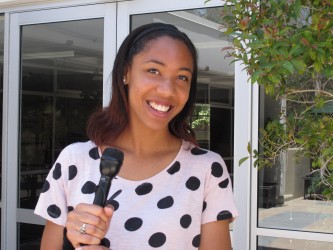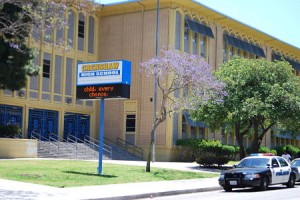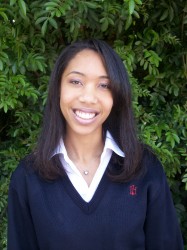As a child, my predominantly African-American enclave in South Los Angeles seemed perfect with its hilly landscape, the view of the city, and the close relationships I had with my neighbors. But in my teens, reality set in and my perspective began to change.
Weekends became my only chance to spend time with other kids like me. We all lived in the same middle-class neighborhood, yet we traveled all over the city for a good education. “Have car, will travel,” became my mother’s refrain. I would attend meetings of Jack and Jill—an African-American community service-based organization— and compare stories with my peers about balancing one-hour commutes with homework and extracurricular activities, and what it’s like to attend schools where there were very few people of color.
I wondered why couldn’t I attend my local public schools, what resources were they lacking, and why neighborhood parents were willing to commute so far?
My neighborhood, Baldwin Hills, may be primarily African American but it is socioeconomically diverse and is divided into two separate areas, the Dons and the Jungle. The Dons, where my family lives, is home to mostly black professionals and is sometimes nicknamed the black Beverly Hills because of their luxury cars and spacious homes. Just below the Dons sits the Jungle, which is made up of uniform blocks of apartment buildings that house mostly poorer African-American residents. It’s known for its frequent drug activity and violence.
My neighborhood high school, Crenshaw High School, is one of the poorest performing schools in the Los Angeles Unified School District. Students from the Jungle tend to go there. Those from the Dons do not. Though in the past the school has been praised for its athletic achievements and served as an icon in the black community, it is now better known for its high dropout rate and low test scores.
As a result, most parents from the Dons send their kids to private, charter, and religious schools out of our area, and often pay $8,000 to $25,000 a year in tuition. I begged my parents not to send me to a private Catholic all-girls high school in another neighborhood, but my father, Karlon Johnson, told me Crenshaw was out of the question because of “overcrowding and underfunding…poor outcomes, too many gangs, dirty schools and not being safe.”
But now, LAUSD is trying to draw Dons parents back to Crenshaw.
In the latest of many attempts to redeem Crenshaw, this August it reopened as three new magnet schools. Local parents at community meetings developed the themes for the new schools: visual and performing arts; business and technology; and science, engineering, math and medicine. The old principal was fired and replaced with three new principals. All the teachers who previously worked there were forced to reapply for their jobs.
“Thousands of students living in the Crenshaw area opt not to go to Crenshaw and choose to go to other schools that are considered magnets,” said LAUSD Director of Intensive Support and Intervention George Bartleson.
“I want the seats filled. I want a waiting list for Crenshaw High School,” he said. “I want to see a rigorous, instructional program for all students.”
Attracting parents from my neighborhood in Baldwin Hills will be a struggle, however. I visited a Jack and Jill meeting there recently and asked parents and students what they thought about the changes at Crenshaw. None of the children were attending public high schools but rather charter and private schools in predominantly white areas such as Hollywood and Brentwood, commuting as far as an hour and a half twice a day.
John May, a Jack and Jill parent, said Crenshaw was still not an option for his daughter in spite of its conversion into a magnet school because of the “accreditation issue that was happening, the quality of teachers and curriculum, and the disorganization of administrators.”
An alumnus of Crenshaw High School, Rosiland Todd, a banker, has a lot of pride in her old school. “Go Cougars!” she chanted when I asked her about her experience. But when asked why she chose to not send her own children to her alma mater in 2006 she said, “Crenshaw at the time was a struggling school, not performing well, there was not a diverse setting, they were struggling with their accreditation and lost their accreditation.” Even if the conversion had happened in 2006, she said, she doubts she would have sent her children to Crenshaw. “I wanted to feel comfortable that there was safety there when I dropped my kids off,” she said, “and that’s why I chose to send them to Loyola High School instead.”
Likewise, long-time Dons resident Wilma Miller teaches in the local public elementary school, but refuses to send her children there or to Crenshaw. “Our neighborhood schools do not meet the requirements for my children,” she said.
The conversion of Crenshaw hasn’t been embraced even among parents who send their children there. Parents and teachers were initially skeptical because “they didn’t feel like they had any say,” said Crenshaw activist Aisha Farley. “These were very ‘top down’ decisions and they wanted to be able to voice their opinion about how their school should be. A lot of community members were not notified. The community has the answers and the solutions to whatever issues we’re facing.” Bartleson clarified that, contrary to some rumors about the changes, the special education program will remain and no specific GPA requirement will be imposed.
I understand why parents from the Dons would not want to send their children to the school, but I also believe something is lost. By not attending our local schools, students miss out on interacting with other kids in their neighborhood and are not as aware of community issues.
 If Dons parents did choose to send their kids to Crenshaw, the school might have a better chance at turning around because it would have middle class parents pushing for change, ambitious students striving to be successful and influencing their peers, and more resources to draw on. Jack and Jill is made up of successful and well-educated parents, who have the resources and drive to change the state of this school. This is an organization with a mission to connect black families through service, and what better way to do this than improving our community’s education system?
If Dons parents did choose to send their kids to Crenshaw, the school might have a better chance at turning around because it would have middle class parents pushing for change, ambitious students striving to be successful and influencing their peers, and more resources to draw on. Jack and Jill is made up of successful and well-educated parents, who have the resources and drive to change the state of this school. This is an organization with a mission to connect black families through service, and what better way to do this than improving our community’s education system?
This story was produced by Reporter Corps, a program of USC Annenberg’s Civic Engagement and Journalism Initiative that trains young adults to report on their own communities, and The Hechinger Report, a nonprofit, nonpartisan education-news outlet affiliated with Teachers College, Columbia University.

















Speak Your Mind